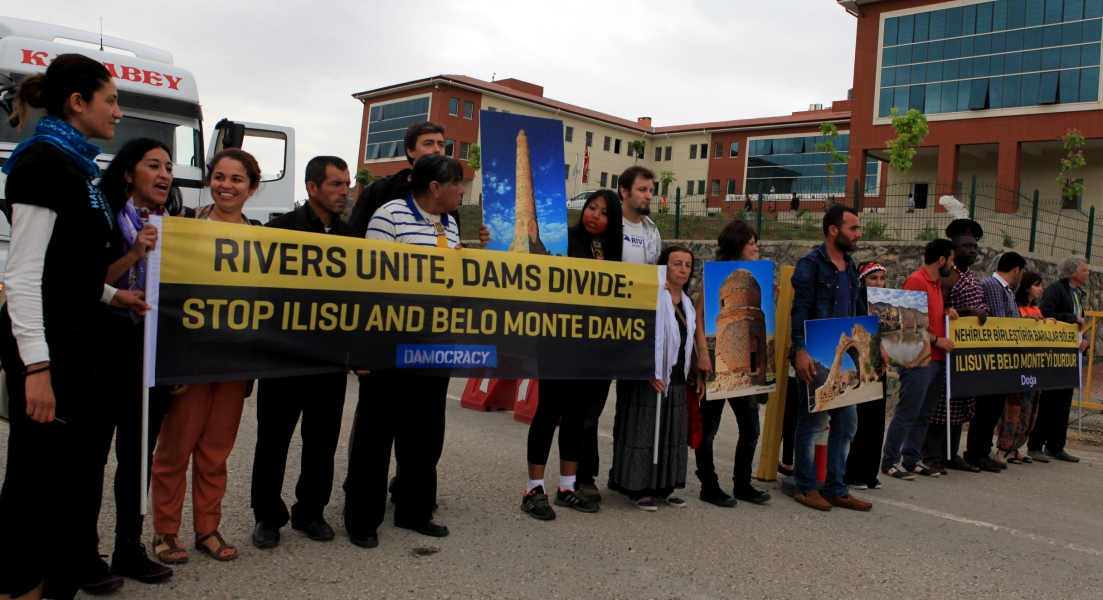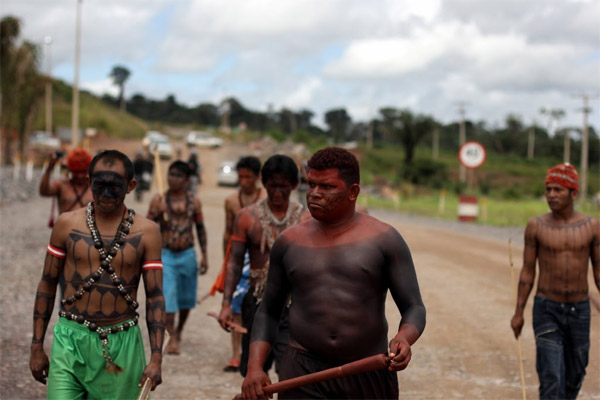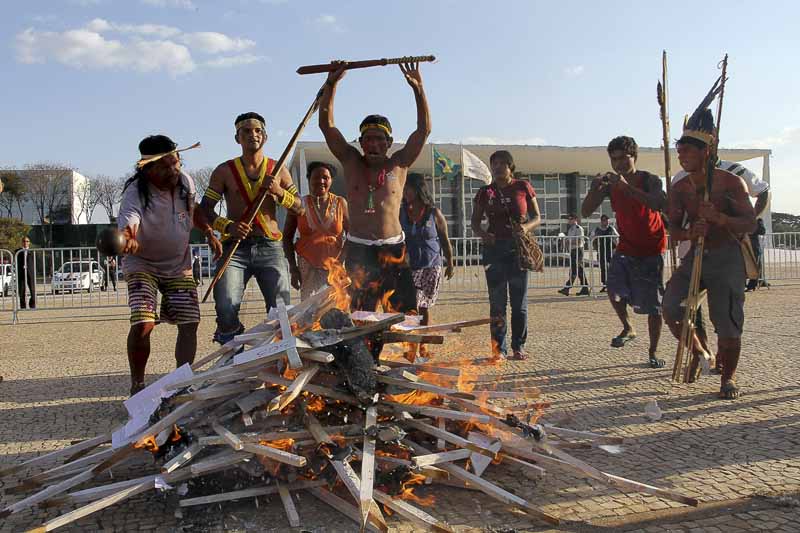
by Deep Green Resistance News Service | May 28, 2013 | Obstruction & Occupation
By Amazon Watch
Today [May 21, 2013] representatives of dam-affected communities and organizations from South America, the Middle East, Europe, the US and Africa, including Brazilian indigenous leaders accompanied by Amazon Watch, blocked the entrance to the construction site of the Ilisu dam in southeast Turkey demanding an end to controversial development that would sink an ancient city dating back to the Bronze Age.
Some 20 people including Kayapó Chief Megaron Txucarramae, one of Brazil’s most noted indigenous leaders in the struggle against the Belo Monte dam in the Amazon, held up banners in English and Turkish reading ‘Rivers Unite, Dams Divide: Stop Ilisu and Belo Monte dams.’ Delegates from the International Rivers Conference held in Istanbul last Saturday joined local protestors to show solidarity with their struggle to stop the Ilisu dam on the Tigris River, Turkey’s last free-flowing river.
“The peace process cannot be completed without the cancellation of the controversial Ilisu dam project and the protection of Hasankeyf. At the same time, damming the Tigris and Euphrates rivers and stopping their flow reaching Syria and Iraq is a contradiction to Turkey’s ‘zero problems’ policy with its neighbors because the increasing water crisis in the Mesopotamian basin may lead to increased conflict,” said Dicle Tuba Kilic, Rivers Program Coordinator for Doga (BirdLife Turkey).
The Belo Monte dam in Brazil and the Ilisu dam in Turkey are two of the most controversial mega-dam projects in the world today. Both dams are located in cultural and natural hotspots, inflicting devastating consequences and displacing over 75,000 people in Amazonia and Mesopotamia. In addition, the Ilisu dam, located a few kilometers from the Iraqi border, will affect the livelihood of Marsh Arabs living in the newly restored Basra Marshes. Turkey controls the Tigris and Euphrates headwaters, which dictates how much water flows downstream into Syria and Iraq.
“Our struggle to preserve the Xingu River from the Belo Monte dam is no different from the fight to protect the Tigris River from the Ilisu dam. We are unified in our positions to say ‘no’ to our governments. You cannot kill a river that sustains its people and culture,” said Kayapó Chief Megaron Txucarramae.
Legal and political controversies have surrounded the push to build the Belo Monte and Ilisu dams. No adequate Environmental Impact Assessment has been carried out for either dam, and both governments have failed to implement prior consultations and mitigation plans to protect the environment and rights of affected communities. Both dams proceed despite court rulings halting their construction and widespread national and international opposition to their development.
Faced by governments steamrolling human rights and environmental protections, dam-affected communities are uniting their struggle under the DAMOCRACY banner. DAMOCRACY includes 15 national and international organizations from all corners of the globe. Among them are Doga Dernegi, Amazon Watch, International Rivers, and RiverWatch.
Damocracy is produced by Doga Dernegi (BirdLife Turkey), in collaboration with other founding members of the Damocracy movement: Amazon Watch, International Rivers, RiverWatch, Gota D’água (Drop of Water) Movement, Instituto Socioambiental (ISA) and Movimento Xingu Vivo para Sempre (MXVPS).
To watch the documentary, visit: http;//www.youtube.com/DamocracyTV
From Amazon Watch: http://amazonwatch.org/news/2013/0521-international-activists-block-ilisu-dam-construction-site-in-turkey

by Deep Green Resistance News Service | May 5, 2013 | Biodiversity & Habitat Destruction, Colonialism & Conquest, Indigenous Autonomy, Obstruction & Occupation
By Mongabay
On Thursday roughly 200 indigenous people launched an occupation of a key construction site for the controversial Belo Monte dam in the Brazilian Amazon. The protestors, who represent communities that will be affected by the massive dam, are demanding immediate suspension of all work on hydroelectric projects on the Xingu, Tapajós and Teles Pires rivers until they are properly consulted, according to a coalition of environmental groups opposing the projects.
The protestors include members of the Juruna, Kayapó, Xipaya, Kuruaya, Asurini, Parakanã, Arara, and Munduruku tribes. Non-indigenous fishermen and riverine community members that will also be affected by Belo Monte have also reportedly joined the demonstration. Organizers say the occupation will continue “indefinitely or until the federal government meets their demands.”
“Today’s protest demonstrates the relentless resistance of a growing group of united peoples against Belo Monte, Tapajós and destructive dams throughout the Amazon,” said Leila Salazar-Lopez, Amazon Watch Program Director, in a statement. “These are the final moments to change course as construction closes in on the Xingu and other lifeline rivers of the Amazon.”
Belo Monte has been the site of several protests since the Brazilian government finalized approval of Belo Monte. Indigenous groups, local fishermen, and environmentalists are strongly opposed to the project, while will divert nearly 80 percent of the flow of the Xingu river, one of the Amazon’s mightiest tributaries. The dam will flood tens of thousands of hectares of land, displace more than 15,000 people, and could push several endemic fish species to extinction. Belo Monte, which will operate at less than 40 percent of capacity despite its $15 billion dollar price tag, will require additional upstream dams to be commercially viable, according to independent analysts, potentially amplifying the project’s impact.
Belo Monte and other dams on the Xingu represent just a small fraction of the hydropower projects being developed by Brazil in the Amazon Basin. According to an analysis published last year, 231 dams are currently planned in the Brazilian Amazon alone. Another 15 are slated for Peru and Bolivia.
Ecologists say there are myriad problems with large dams in tropical ecosystems, especially when built on the scale envisioned in the Amazon. Large dams interfere with the hydrological cycle and nutrient flows through an ecosystem, while restricting or blocking access to breeding and feeding grounds for migratory fish species. Meanwhile areas inundated with water can generate substantial greenhouse gas emissions. Design flaws in some tropical dams, which draw methane from the base of their reservoirs, can exacerbate climate impacts. Finally flooding in the reservoir area can displace communities traditionally dependent on rivers, while creating hardship downstream from degraded fisheries.
From Mongabay: “Tribesmen launch ‘occupy’ protest at dam site in the Amazon rainforest“

by Deep Green Resistance News Service | Nov 13, 2012 | Indigenous Autonomy, Property & Material Destruction, Reclamation & Expropriation, Worker Exploitation
By Agence France-Presse
Work on Brazil’s controversial $13 billion Belo Monte mega-dam ground to a halt Monday after protesters torched buildings at three dam construction sites over the weekend, the developer said.
Saturday, “a group of 30 people set fire to prefab structures at the Pimental site. They went into the cafeteria, destroyed everything and robbed the till” before setting it ablaze, said Fernando Santana, spokesman for builders Consorcio Constructor Belo Monte (CCBM).
And late Sunday, groups of 20 people set structures ablaze at Canais and Diques, two other dam construction sites, said Santana.
“On Monday, as a precautionary security measure, all activities were suspended at the construction site,” said Santana, suggesting that “vandals” might be trying to derail salary renegotiation under way.
The state-owned Norte Energia hired CCBM to build the dam, which is set to be the world’s third largest when it has been completed. Between 12,000 and 13,000 workers would be employed at the site on two shifts, Santana said.
The incidents broke out after CCBM proposed a seven percent wage hike to the workers in an area where the inflation rate is at 30 percent, said Xingu Vivo, a non-governmental group opposing the dam.
On October 9 protesters — 150 natives and local fishermen — interrupted dam construction, accusing Norte Energia of backtracking on accords signed in June when people occupied the Pimental area for three weeks.
Indigenous groups fear the dam across the Xingu River, a tributary of the Amazon, will harm their way of life. Environmentalists have warned of deforestation, greenhouse gas emissions and irreparable damage to the ecosystem.
The dam is expected to flood some 500 square kilometers (200 square miles) along the Xingu and displace 16,000 people, according to the government, although some NGOs put the number at 40,000 displaced.
The natives want their lands demarcated and non-indigenous people removed from them, as well as a better healthcare system and access to drinking water.
Expected to produce 11,000 megawatts of electricity, the dam would be the third biggest in the world, after China’s Three Gorges facility and Brazil’s Itaipu Dam in the south.
It is one of several hydroelectric projects billed by Brazil as providing clean energy for a fast-growing economy.
“Avatar” director James Cameron and actress Sigourney Weaver support dam opponents, drawing parallels with the natives-versus-exploiters storyline of their blockbuster Hollywood movie.
From Bangkok Post: http://www.bangkokpost.com/news/world/320956/trouble-at-brazil-mega-dam-stops-construction-for-now

by Deep Green Resistance News Service | Oct 9, 2012 | Biodiversity & Habitat Destruction, Colonialism & Conquest, Indigenous Autonomy, Obstruction & Occupation
By Jeremy Hance / Mongabay
Construction on Brazil’s megadam, Belo Monte, has been halted again as around 150 demonstrators, most of them from nearby indigenous tribes, have occupied the main construction site at Pimental. Over a hundred indigenous people joined local fishermen who had been protesting the dam for 24 days straight. Indigenous people and local fishermen say the dam will devastate the Xingu River, upending their way of life.
“The renewed occupation of the project’s earthen cofferdams paralyzed construction works, while indigenous protestors seized the keys of trucks and tractors forcing workers to leave the strategic Pimental work camp on foot,” reads a press release from the NGO Amazon Watch. Around 900 workers were sent home.
This is the second occupation attempt in less than six months. Over the summer some 300 indigenous people sustained an occupation of the dam for 21 days, before breaking it off though little headway was made in talks with consortium building the dam, Norte Energia.
The Belo Monte dam, which would be the world’s third largest, has been plagued by controversy from its origin decades ago; the battle for the dam has been fought both in Brazil’s courts and on the international stage. If built, the dam will flood an estimated 40,000 hectares of present rainforest and could push some fish species to extinction. In addition, 16,000 people will be displaced according to the government, though some NGOs say the number is more likely double that.
Despite the impacts, the dam has been strongly supported by Brazilian President Dilma Rousseff, and every legal injunction against the dam has been overturned. Norte Energia has filed with a local court for repossession of the construction sties.
Indigenous groups say the construction of the dam is already imperiling their way of life, as the Xingu river becomes more difficult to navigate. They have also said they have no intention of leaving until Norte Energia meets their demands.
“We are witnessing the devastation of this land. The island of Pimental was completely destroyed, with a sole tree left standing, and the water is putrid. It is very shocking,” an protestor told Amazon Watch.
Dams are often described as ‘green’ energy source, however in the tropics they actually release significant methane emissions due to rotting vegetation. Although it has a shorter life than carbon, methane is a far more potent greenhouse gas.
From Mongabay: “Indigenous groups re-occupy Belo Monte dam in the Amazon“
by Deep Green Resistance News Service | Aug 28, 2012 | Colonialism & Conquest, Indigenous Autonomy
By Agence France-Presse
Brazil’s Supreme Court has approved the resumption of work on the huge Belo Monte dam in the Amazon, which was halted earlier this month after protests from indigenous groups.
The preliminary ruling on Monday overturns an earlier ruling that ordered construction of the dam across the Xingu River, a tributary of the Amazon, to be stopped until indigenous peoples can testify before Congress.
However, the decision by Supreme Court President Carlos Ayres Britto could be revised when the court examines the case further, its website said.
The dam, expected to produce 11,000 megawatts of electricity, would be the third-biggest in the world, after China’s Three Gorges facility and Brazil’s Itaipu dam in the south.
A regional federal court, in the earlier ruling, had noted that when Congress approved the project in 2005, it called for an environmental impact study after the start of the work.
By law, the native communities had the right to air their views in Congress on the basis of the study, but this was not done, the court said.
Work on the dam began a year ago, despite fierce opposition from local residents and green activists.
Indigenous groups fear the dam will harm their way of life while environmentalists have warned of deforestation, greenhouse gas emissions and irreparable damage to the ecosystem.
“Avatar” director James Cameron and actress Sigourney Weaver have given their backing to dam opponents, drawing parallels with the natives-versus-exploiters storyline of their blockbuster Hollywood movie.
Belo Monte is expected to flood an area of 500 square kilometers (200 square miles) along the Xingu, and displace 16,000 people, according to the government. Some NGOs estimate that 40,000 people would be displaced.
From Yahoo! News:




